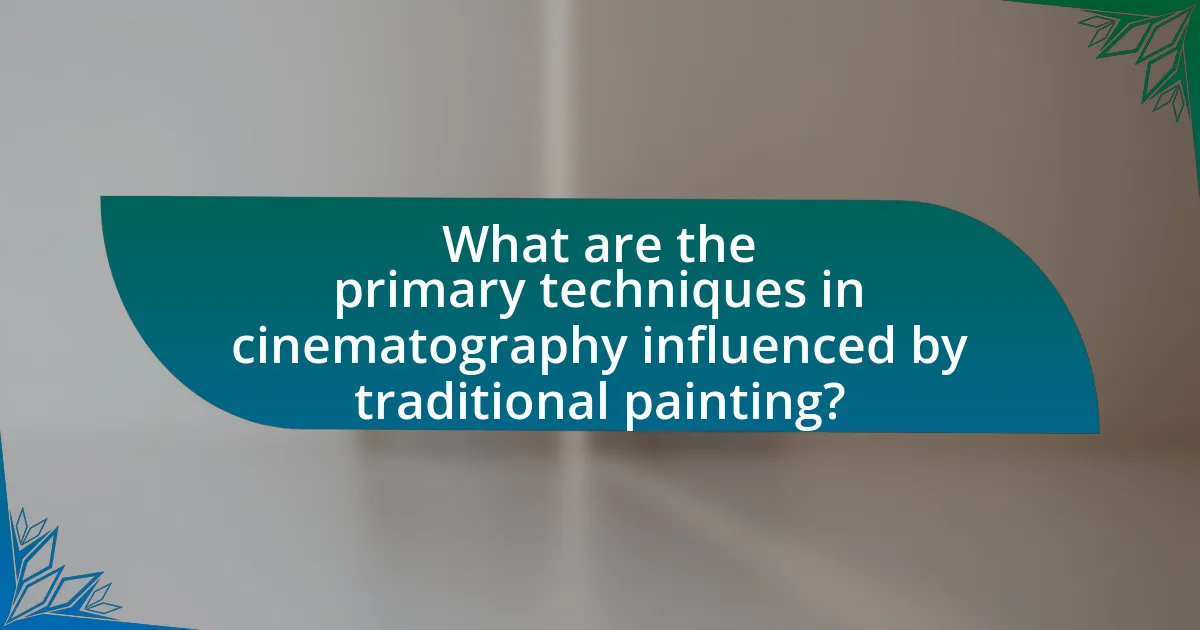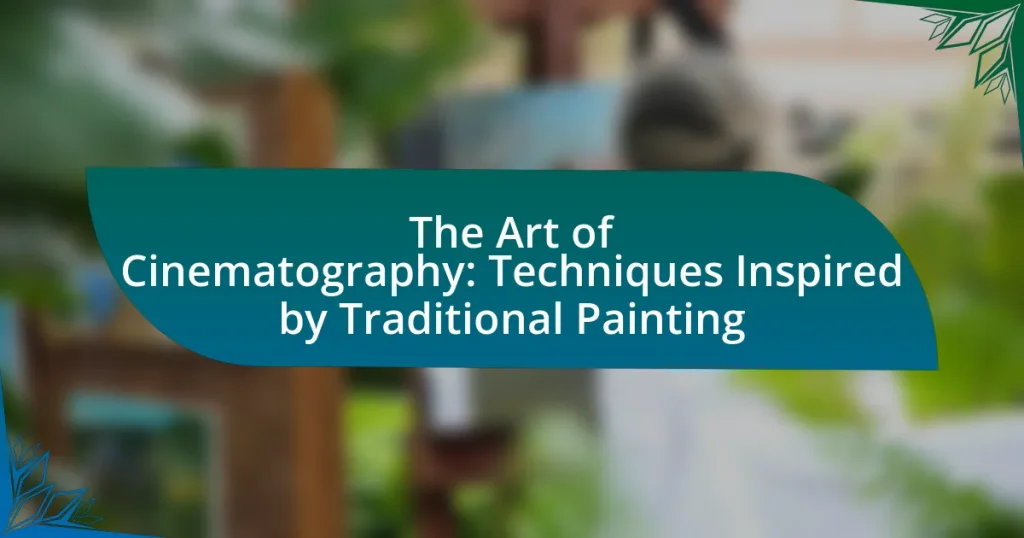The Art of Cinematography: Techniques Inspired by Traditional Painting explores the integration of visual principles from classical painting into film photography, emphasizing composition, color theory, and lighting. This article examines how filmmakers, such as Vittorio Storaro and Wes Anderson, utilize techniques like chiaroscuro and color palettes reminiscent of renowned artists to enhance visual storytelling. Key elements discussed include the influence of traditional painting on cinematographic composition, the emotional impact of color, and the historical contexts that highlight the relationship between these two art forms. Additionally, the article addresses practical steps filmmakers can take to implement these techniques effectively while avoiding common pitfalls.

What is The Art of Cinematography: Techniques Inspired by Traditional Painting?
The Art of Cinematography: Techniques Inspired by Traditional Painting refers to the practice of applying visual principles from classical painting to film photography. This approach emphasizes composition, color theory, and lighting techniques that mirror the aesthetics of renowned painters, enhancing the visual storytelling in cinema. For instance, filmmakers like Vittorio Storaro have drawn from the works of Caravaggio and Rembrandt, utilizing chiaroscuro lighting to create depth and emotion in their scenes. This blending of art forms enriches the cinematic experience, making it more visually compelling and artistically profound.
How does cinematography draw inspiration from traditional painting?
Cinematography draws inspiration from traditional painting through the use of composition, color theory, and lighting techniques. Cinematographers often emulate the framing and arrangement of elements found in classic artworks, such as the rule of thirds and leading lines, to create visually compelling scenes. Additionally, color palettes in films frequently reflect the emotional tones established in paintings, utilizing complementary and analogous colors to evoke specific feelings. Lighting in cinematography mirrors the chiaroscuro technique used by painters, where contrasts between light and shadow enhance depth and drama. This relationship is evident in films like “The Grand Budapest Hotel,” where Wes Anderson’s use of color and symmetry is reminiscent of the works of artists like Henri Matisse.
What are the key elements of traditional painting that influence cinematography?
Key elements of traditional painting that influence cinematography include composition, color theory, and lighting. Composition in painting, such as the rule of thirds, guides the framing of shots in cinematography, ensuring visual balance and focus. Color theory, which explores the emotional impact of colors, informs cinematographers on how to evoke specific moods and atmospheres in film. Lighting techniques derived from traditional painting, such as chiaroscuro, enhance depth and dimension in cinematography, creating dramatic contrasts that draw viewers’ attention. These elements have been historically recognized in the works of painters like Rembrandt and Vermeer, whose techniques have been adapted by filmmakers to enhance storytelling visually.
How do color palettes in painting translate to cinematographic techniques?
Color palettes in painting translate to cinematographic techniques through the use of color grading, lighting, and composition to evoke emotions and set the tone of a scene. Cinematographers often draw inspiration from the color theories established by painters, such as the use of complementary colors to create contrast or analogous colors for harmony. For instance, films like “The Grand Budapest Hotel” utilize a pastel color palette reminiscent of Impressionist paintings, enhancing the whimsical narrative. This approach is supported by studies in visual perception, which indicate that color can significantly influence audience emotions and interpretations, as demonstrated in research by the American Psychological Association.
Why is the fusion of painting and cinematography significant?
The fusion of painting and cinematography is significant because it enhances visual storytelling by integrating the aesthetic principles of painting into film. This combination allows filmmakers to create more evocative imagery, utilizing techniques such as composition, color theory, and lighting that are foundational in painting. For instance, directors like Vittorio Storaro have drawn inspiration from the works of painters like Caravaggio and Rembrandt, employing chiaroscuro to evoke emotion and depth in cinematography. This blending not only enriches the visual experience but also deepens the narrative impact, as seen in films that consciously mimic the style of classic artworks, thereby creating a dialogue between the two art forms.
What historical contexts highlight the relationship between painting and film?
The historical contexts that highlight the relationship between painting and film include the influence of the Renaissance on cinematic composition and the adoption of Impressionist techniques in early cinema. During the Renaissance, artists like Leonardo da Vinci and Caravaggio established principles of perspective and light that filmmakers later utilized to create depth and mood in their scenes. Additionally, the Impressionist movement, characterized by its focus on capturing light and movement, inspired filmmakers such as the Lumière brothers and Georges Méliès, who incorporated similar techniques to evoke emotion and realism in their films. These artistic movements laid the groundwork for visual storytelling in cinema, demonstrating a direct lineage from painting to film.
How does this fusion enhance storytelling in cinema?
The fusion of traditional painting techniques with cinematography enhances storytelling in cinema by creating visually rich narratives that evoke emotional responses. This integration allows filmmakers to utilize color palettes, composition, and lighting inspired by classic artworks, which can deepen the audience’s connection to the story. For instance, the use of chiaroscuro, a technique prominent in Baroque painting, can create dramatic contrasts that emphasize character emotions and thematic elements, as seen in films like “The Godfather.” Such visual strategies not only support the narrative but also elevate the overall aesthetic experience, making the storytelling more immersive and impactful.

What are the primary techniques in cinematography influenced by traditional painting?
The primary techniques in cinematography influenced by traditional painting include composition, lighting, and color theory. Composition in cinematography often mirrors the principles of balance and focal points found in classical paintings, guiding the viewer’s eye through the frame. Lighting techniques, such as chiaroscuro, draw from the dramatic contrasts seen in paintings to create depth and mood. Additionally, color theory in cinematography is influenced by the use of color palettes in painting, where specific colors evoke emotions and set the tone of the scene. These techniques are validated by the works of renowned cinematographers who have explicitly referenced traditional art in their visual storytelling, such as Roger Deakins and Emmanuel Lubezki, who utilize these artistic principles to enhance narrative and visual impact.
How do lighting techniques in cinematography reflect painting styles?
Lighting techniques in cinematography often mirror painting styles by utilizing chiaroscuro, color palettes, and composition to evoke specific moods and emotions. For instance, chiaroscuro, a technique used by artists like Caravaggio, emphasizes strong contrasts between light and dark, which cinematographers replicate to create depth and drama in scenes. Additionally, the use of color temperature in lighting can reflect the emotional tone found in paintings; warm tones may evoke feelings of comfort or nostalgia, akin to the works of Impressionist painters, while cooler tones can create a sense of detachment or tension, similar to the styles of modernist artists. Historical examples include the use of Rembrandt lighting in film, which draws directly from the painter’s technique of illuminating subjects in a way that highlights their features while casting dramatic shadows, thereby enhancing the narrative visually.
What are the similarities between chiaroscuro in painting and lighting in film?
Chiaroscuro in painting and lighting in film both utilize the contrast between light and shadow to create depth, mood, and focus. In painting, chiaroscuro enhances three-dimensionality and directs the viewer’s attention to specific elements, as seen in the works of Caravaggio, who employed this technique to evoke emotion and drama. Similarly, in film, lighting techniques such as low-key lighting create stark contrasts that shape the narrative and influence audience perception, as demonstrated in classic noir films where shadows play a crucial role in establishing tension and atmosphere. Both mediums rely on the interplay of light and dark to convey meaning and enhance visual storytelling.
How can filmmakers use lighting to evoke emotions similar to those in paintings?
Filmmakers can use lighting to evoke emotions similar to those in paintings by manipulating light intensity, color, and direction to create mood and atmosphere. For instance, chiaroscuro lighting, which emphasizes strong contrasts between light and dark, can evoke feelings of drama and tension, akin to the works of Caravaggio. Additionally, warm color temperatures can elicit feelings of comfort and nostalgia, similar to the soft, golden hues found in Impressionist paintings. Studies in visual perception indicate that color and light significantly influence emotional responses, supporting the effectiveness of these techniques in film.
What role does composition play in both painting and cinematography?
Composition serves as a fundamental element in both painting and cinematography, guiding the viewer’s eye and conveying meaning. In painting, composition involves the arrangement of visual elements to create balance, focus, and harmony, which can evoke emotions and tell a story. Similarly, in cinematography, composition dictates how scenes are framed, influencing the narrative and emotional impact of the film. For instance, the rule of thirds, a common compositional technique in both fields, helps to create dynamic and engaging visuals by positioning subjects along intersecting lines, enhancing viewer engagement. This shared emphasis on composition underscores its critical role in shaping the aesthetic and communicative power of both art forms.
How do the rules of composition in painting apply to framing shots in film?
The rules of composition in painting directly influence the framing of shots in film by guiding visual storytelling through elements such as balance, contrast, and focal points. In both mediums, the use of the rule of thirds enhances viewer engagement by positioning key subjects along intersecting lines, creating a more dynamic and visually appealing composition. Additionally, techniques like leading lines and framing within the frame, commonly used in painting, help direct the viewer’s attention and establish depth in film shots. Historical examples, such as the influence of Renaissance painters on cinematographers, demonstrate how these compositional strategies enhance narrative clarity and emotional resonance in visual storytelling.
What are some examples of famous films that utilize painterly composition?
Famous films that utilize painterly composition include “The Grand Budapest Hotel,” “Amélie,” and “The Fall.” “The Grand Budapest Hotel,” directed by Wes Anderson, is known for its symmetrical framing and vibrant color palette, reminiscent of classical paintings. “Amélie,” directed by Jean-Pierre Jeunet, employs rich colors and whimsical compositions that evoke a storybook aesthetic. “The Fall,” directed by Tarsem Singh, features stunning visuals that draw inspiration from various art styles, creating a dreamlike quality akin to paintings. These films exemplify how cinematography can reflect traditional artistic techniques, enhancing visual storytelling.

How can filmmakers effectively implement painting-inspired techniques in their work?
Filmmakers can effectively implement painting-inspired techniques by utilizing composition, color theory, and lighting that reflect traditional painting styles. For instance, filmmakers can adopt the rule of thirds and leading lines, which are common in classical paintings, to create visually compelling scenes. Additionally, they can apply color palettes inspired by famous artists, such as using the warm tones of Van Gogh or the cool hues of Monet, to evoke specific emotions and atmospheres. Lighting techniques, such as chiaroscuro, can also be employed to create depth and contrast, mirroring the dramatic effects seen in paintings. These methods enhance storytelling by visually engaging the audience and creating a rich, artistic experience that resonates with the aesthetics of traditional art.
What practical steps can filmmakers take to incorporate these techniques?
Filmmakers can incorporate techniques inspired by traditional painting by studying the composition, color palettes, and lighting used in classic artworks. For instance, they can analyze the rule of thirds and leading lines found in paintings to enhance visual storytelling. Additionally, filmmakers should experiment with color grading to evoke specific emotions, similar to how artists use color to convey mood. Implementing chiaroscuro lighting techniques can create depth and drama, mirroring the contrasts seen in paintings. Furthermore, filmmakers can collaborate with art directors to design sets that reflect the aesthetic qualities of traditional art, ensuring that every frame resonates with the visual language of painting.
How can studying traditional painting improve a cinematographer’s skill set?
Studying traditional painting can significantly enhance a cinematographer’s skill set by improving their understanding of composition, color theory, and lighting. Traditional painting emphasizes the arrangement of elements within a frame, which directly translates to cinematography, where framing and composition are crucial for storytelling. Additionally, knowledge of color theory from painting allows cinematographers to create mood and atmosphere through color palettes, influencing audience perception. Furthermore, traditional painting techniques often involve a deep exploration of light and shadow, which can inform a cinematographer’s approach to lighting setups, enhancing the visual depth and realism of their work. This connection between the two art forms is supported by the historical influence of painters on early cinematographers, who adopted similar principles to create compelling visual narratives.
What resources are available for filmmakers to learn about these techniques?
Filmmakers can access various resources to learn about techniques inspired by traditional painting, including online courses, books, and workshops. Online platforms like MasterClass and Coursera offer courses specifically focused on cinematography and visual storytelling, often featuring industry professionals. Books such as “Cinematography: Theory and Practice” by Blain Brown provide in-depth knowledge on the subject, while workshops conducted by film schools or organizations like the American Film Institute offer hands-on experience and mentorship. These resources collectively enhance filmmakers’ understanding of integrating painting techniques into cinematography.
What common challenges do filmmakers face when blending painting and cinematography?
Filmmakers commonly face challenges such as achieving visual coherence, managing lighting, and balancing artistic styles when blending painting and cinematography. Visual coherence is crucial because filmmakers must ensure that the painted elements harmonize with the cinematic visuals, which can be difficult due to differing color palettes and textures. Managing lighting presents another challenge, as the lighting used in cinematography must complement the painted elements to maintain a unified aesthetic. Additionally, balancing artistic styles requires filmmakers to navigate the distinct techniques of painting and cinematography, ensuring that neither overshadows the other, which can lead to a disjointed final product. These challenges are evident in works that attempt to merge these two art forms, highlighting the complexity of achieving a seamless integration.
How can filmmakers overcome the limitations of technology in achieving painterly effects?
Filmmakers can overcome the limitations of technology in achieving painterly effects by utilizing advanced post-production techniques and integrating traditional artistic methods. For instance, filmmakers can employ digital painting software to manipulate frames, allowing for the creation of textures and colors reminiscent of classic paintings. Additionally, techniques such as rotoscoping and compositing enable the blending of live-action footage with painted elements, enhancing the visual aesthetic. Historical examples include the use of digital tools in films like “Loving Vincent,” which utilized over 65,000 hand-painted frames to achieve a Van Gogh-inspired look, demonstrating that combining technology with traditional artistry can yield compelling painterly effects.
What are some pitfalls to avoid when applying these techniques in film?
When applying techniques inspired by traditional painting in film, one major pitfall to avoid is overemphasis on visual aesthetics at the expense of narrative coherence. This can lead to visually stunning scenes that lack emotional depth or clarity, ultimately disengaging the audience. For instance, filmmakers may focus excessively on replicating the color palettes or composition styles of famous paintings, which can overshadow character development and plot progression. Additionally, neglecting the unique temporal and spatial dynamics of film can result in static compositions that do not leverage the medium’s strengths, such as movement and pacing. Historical examples, such as the criticism faced by films that prioritize style over substance, highlight the importance of balancing visual artistry with storytelling to maintain audience engagement.
What are the best practices for utilizing painting-inspired techniques in cinematography?
The best practices for utilizing painting-inspired techniques in cinematography include employing color palettes, composition, and lighting that mimic traditional painting styles. Cinematographers can analyze the works of renowned painters, such as Caravaggio’s use of chiaroscuro or Monet’s impressionistic color schemes, to inform their visual storytelling. For instance, using a limited color palette can create mood and focus, similar to how artists convey emotion through color. Additionally, framing shots with an emphasis on balance and symmetry, akin to classical compositions, enhances visual appeal. Lighting techniques that replicate the natural light found in paintings can also add depth and texture to scenes, reinforcing the artistic connection. These practices are validated by the historical influence of visual art on film, as many acclaimed films draw inspiration from specific artworks, demonstrating the effectiveness of these techniques in enhancing cinematic storytelling.


